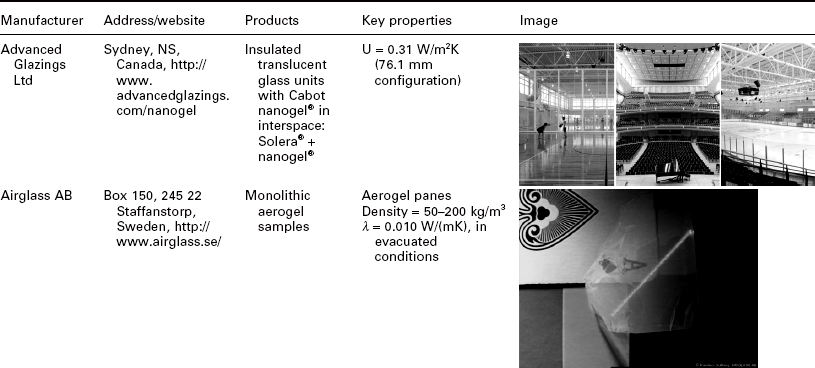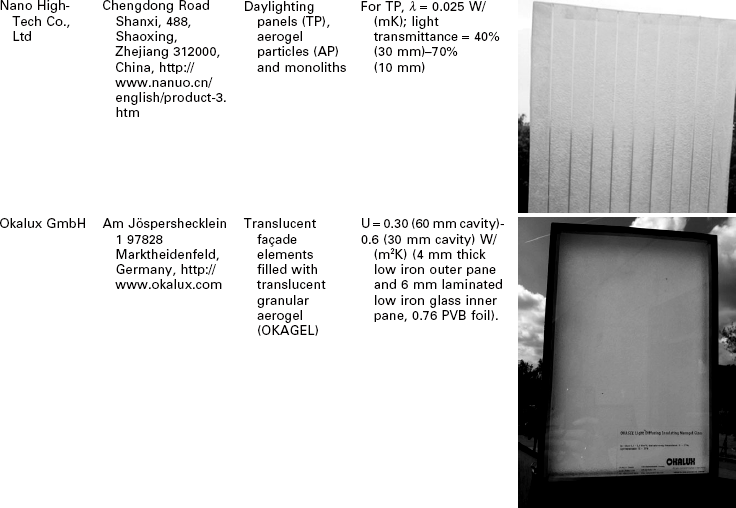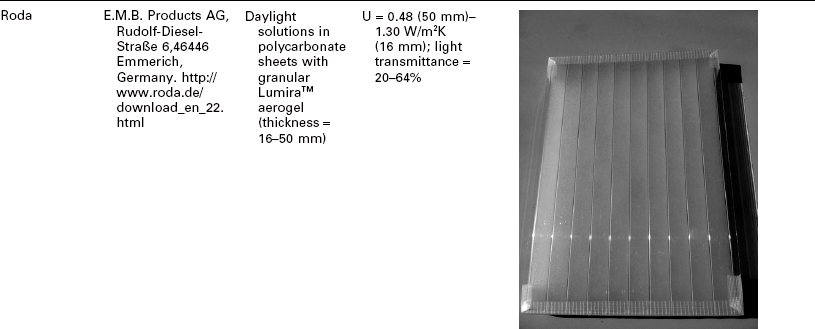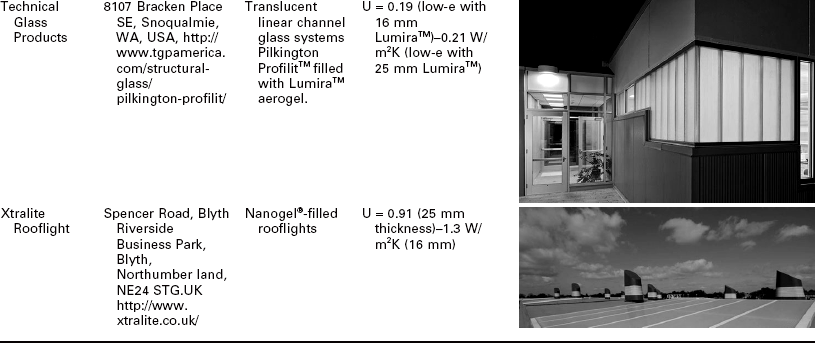Silica nanogel for energy-efficient windows
Abstract:
This chapter discusses the utilization of silica nanogel to develop high energy-efficient windows and skylights. Silica aerogels are firstly discussed in terms of chemical structure, production process, and physical, mechanical, and thermal properties. The chapter then reviews their current applications in buildings as thermal and acoustic insulation materials. Finally, the potential of the nanogel windows for energy saving in buildings and the main future research trends are discussed.
10.1 Introduction
The global share of buildings in energy consumption has progressively increased, reaching a value of about 40% in developed countries. Because of the increasing demand for building services and comfort levels, the upward trend in energy consumption is expected to continue in the future (Pérez-Lombard et al., 2008), above all in emerging economy nations (Southeast Asia, Middle East, South America and Africa). Energy policies at regional, national, and international level have therefore made energy saving one of the main objectives in residential and non-residential buildings (offices, public buildings, etc.), as shown by the recent directives of the European Parliament on building energy performance (European Parliament and the Council of the European Union, 2002). Moreover, according to data contained in a Pike Research report (2011), the total market for energy efficiency in buildings is rapidly increasing: from an estimated value of $67.9 billion in 2011, it is expected to pass $103.5 billion by 2017. In a building, the main total energy losses (up to 60%) can depend on the windows (Jelle et al., 2012).
Windows have a double role in the building thermal envelope (Zanetti Freire et al., 2011):
• thermal transmission properties have to be as low as possible in order to reduce energy consumption for heating and air conditioning;
• light transmission characteristics have to be as high as possible for visual comfort and electric energy saving in illuminating plants, thanks to natural lighting.
Moreover, windows should guarantee natural ventilation, above all in residential buildings. Finally, they have to also assure adequate acoustic insulation (Oral et al., 2004). Highly energy-efficient windows such as nanogel windows (with silica aerogels in the interspace) could satisfy both these requirements, due to their high thermal insulation coefficient (thermal conductivity of silica aerogel is as low as 0.010 W/mK) and high light transmittance. A state-of-the-art market review of the best performing windows (AbuBakr et al., 2008; Jelle et al., 2012) showed that research has focused on lower thermal transmittance values of less than 0.5 W/(m2K). Vacuum glazings, smart windows, solar cell glazing, electrochromic windows and finally aerogel windows were considered and investigated as the best solutions.
Aerogel windows, for which one of the lowest centre of glass U-values was found (0.30 W/m2 K), seem to have the greatest potential for improving the thermal performance, daylight, and solar properties in the windows sector. Aerogel is a highly porous nanostructured and light material, with many particular properties that attracted the attention of researchers in various areas of science and technology, and also for building applications. The term ‘aerogel’ was first introduced over 80 years ago, marking gels in which the liquid was replaced with a gas, without collapsing the solid network of the gel (Kistler, 1931). Afterwards, the chemical composition of the material and the applications were progressively diversified, but a great part of applications was focused on the development of high-performance thermal insulation materials. The most promising applications in buildings involved granular translucent aerogels and transparent monolithic silica aerogels (Baetens et al., 2011). Transparent monolithic panes were developed by a Swedish company in the 1990s, but advanced glazing systems with monolithic aerogel in the interspace are not yet used in mass production (Duer and Svendsen, 1998; Jensen et al., 2004; Schultz and Jensen, 2008).
At the same time, granular translucent aerogels with an acceptable transparency were manufactured and, starting from 2005, many daylighting systems (polycarbonate panels, structural panels for continuous façades, insulated glasses) with translucent granular aerogel in the interspace appeared on the market (Rigacci et al., 2004), offering excellent thermal performance, high quality of the diffused light, a good solar heat gain, and good sound insulation characteristics (Reim et al., 2005). Nowadays, especially in the last two decades, the production of aerogels is localized in Europe (Sweden, Germany), USA, Japan, and Russia. This chapter investigates the utilization of silica aerogel in the interspace of highly energy-efficient windows. The production process of silica aerogels and the main physical, mechanical, and thermal properties are discussed first. Then, the current building applications of aerogels as thermal and acoustic transparent insulation material (TIM) in windows are discussed in more detail and the performance of nanogel windows is underlined and compared with conventional glazing solutions. Finally, the main future research trends are discussed.
10.2 Aerogels for windows
Aerogels have a large number of applications and they differ from each other if the raw material is considered. They can be classified into:
• inorganic (silica-based and non-silicate aerogels);
• organic (natural and synthetic);
For the purposes of the present chapter, inorganic silica-based aerogels will be considered, which are the most common as transparent insulating materials (TIM), both in the form monolithic and granular materials.
10.2.1 Synthesis and production of silica aerogels
Aerogels are light and transparent solid materials obtained from a gel by replacing the pore liquids with air and maintaining the network structure as it is in the gel state. Silica aerogels are manufactured by means of different processes; all them involve three general steps (Pierre and Pajonk, 2002; Dorcheh and Abbasi, 2008; Baetens et al., 2011):
Gel preparation (sol-gel process)
The raw materials for the aerogel production are solid particles. In particular, silicon alkoxides are often used, such as tetramethoxysilane (TMOS, Si(OCH3)4), tetraethoxysilane (TEOS, Si(OC2H5)4), and polyethoxydisiloxane (PEDS-Px, SiOn(OC2H5)4–2n). They are dispersed in a liquid where the solid nanoparticles collide and form a solid three-dimensional network, which can extend through the liquid (silica sols). Acidic or basic catalysts are usually added in the process. The gels are usually classified according to the dispersion medium used, e.g., hydrogel, alcogel and aerogel (for water, alcohol, and air, respectively). The following reaction may describe the synthesis of silica aerogels for insulation purposes (when the precursor is tetramethoxysilane, Si(OCH3)4):
The material resulting from the process is a cross-linked structure (Fig. 10.1) of silicon dioxide (SiO2) chains (0.2–15% in volume, depending on the manufacturing method) with a large number of air-filled pores.

10.1 Structure of the nanoporous SiO2 network of silica aerogel (Reim et al., 2005).
Gel ageing
before drying, in order to increase stiffness and strength and to mechanically reinforce the tenuous solid skeleton generated during the sol-gel process. Different ageing techniques can be used. They are based on modifying the composition of the liquid phase contained in the pores by adding water and/or monomeric alkoxylanes. In fact, a significant number of the alcoxides contained in the liquid could be unreacted. The addition of these substances can enhance the surface reactions and allow supplementary condensation and re-precipitation of silica on the skeleton. The mechanisms operating during the ageing phase are the neck growth from reprecipitation of silica dissolved from particle surface onto necks between particles, and the dissolution of smaller particles and precipitation onto larger ones. The consequence is generally an increasing of the average pore size and of the apparent density of the gel. After ageing, the water still within the pores must be removed, by washing the gel with ethanol and heptanes. If water remains in the pores, it will not be removed with supercritical drying, therefore it will lead to an opaque and very dense gel.
Gel drying
Aerogels are the solid framework of the sol-gel isolated from liquid by means of the drying phase; it is the most critical step of the process, because it is governed by the capillary pressure which can cause fractures or collapse in the structure. Two different methods are usually used: ambient pressure drying (APD) and supercritical drying (SCD), where the capillary tension can be avoided by removing the liquid above the critical temperature and pressure. APD is generally carried out in two steps:
• Firstly, the solvent is replaced with a water-free solvent and a silylating agent, so that the OH groups are silylated.
• Evaporation at ambient pressure is made in three steps: a warming period; a first drying period in which water moves to the external surface by capillary forces; a second drying period dominated by a diffusive vapour transport that allows liquid to escape slowly to the exterior.
SCD can be carried out by one of two methods:
• Light temperature supercritical drying (HTSCD), which occurs in three steps (the autoclave, half-filled with the aged gel, is sealed and heated slowly past the critical temperature and pressure, then it is isothermally depressurized, and finally, at ambient pressure, it is cooled to room temperature).
• Low temperature supercritical drying (LTSCD), similar to HTSCD and also carried out in three steps (the aged gel is placed in an autoclave and filled with CO2 at 4–10 °C and 100 bar, to replace the solvent in the pores, and it is heated to 40 °C maintaining 100 bar; then it is isothermally depressurized and finally, at ambient pressure, it is cooled at room temperature).
For building applications, monolithic aerogels are manufactured with a LTSCD process. The APD process was nevertheless studied (Kim and Hyum, 2003) in order to lower the production costs and it is today the most promising technique. The production process of the commercial translucent granular aerogel, nanogel®, manufactured by Cabot Corporation (the main manufacturer of granular translucent aerogels), is schematized in Fig. 10.2. A water-based silica solution is destabilized and a gel is created (hydrogel); then, in the silation phase, an organic solvent replaces the water in the formulation. Finally, the solvent is removed by a drying process under ambient conditions. The innovative manufacturing process developed by Cabot allows production on a large scale, overcoming the problems that occur in the supercritical drying method, and it also allows careful control of the material’s properties, such as porosity (> 90% air) and pores size (Aegerter et al., 2011). A more detailed analysis of the synthesis process and of the recent developments can be found in the literature (Dorcheh and Abbasi, 2008; Aegerter et al., 2011).
10.2.2 Physical, mechanical, and thermal properties of silica aerogels
The final physical, optical, and thermal properties of silica aerogels depend on both the starting silica source (TEOS, TMOS, PEDS-Px) and the process methodology, in particular on the catalyst and solvent used (Tajiri and Igarashi, 1998; Pajonk, 2003; Anderson et al., 2009). Aerogels have unusual properties as solid materials, due to their structure. Furthermore, the physical, mechanical, and thermal characteristics can vary over a wide range, depending on the synthesis process.
Physical properties
Silica aerogels are amorphous materials; the skeleton density is about 2200 kg/m3, but the material is extremely light (the bulk density is in the 50–200 kg/m3 range), due to the very high porosity (the pore volume is above 90% of the total volume). The pore size is typically in the 5–100 nm range. Current aerogels for building applications have an overall density of 70–150 kg/m3. The acoustic properties are very interesting: the acoustic propagation through aerogels depends on the nature and pressure of the interstitial gas, on the aerogel density, and more on the texture (Forest et al., 1998), but the speed of sound in silica aerogels is lower than in air (down to about 40 m/s through monolithic aerogels and to about 100 m/s through granular ones). They can also improve the sound insulation in windows (see Section 10.4). The optical and scattering properties are discussed in the next paragraphs.
Mechanical properties
Aerogels are very fragile materials: the tensile strength is negligible, the compressive strength and the elastic modulus are very low, and they depend on the network connectivity and density. The compressive strength is in the 1–2 MPa range (Parmenter and Milstein, 1998; Luo et al., 2006). The Young’s modulus (E) is a function of the apparent density. It varies in the 10–3–10 GPa range, when the apparent density varies in the 102–2 × 103 kg/m3 (Woignier et al., 1988; Hegde and Venkateswara Rao, 2007; Parmenter and Milstein, 1998); in Aegerter et al. (2011) an E value in the 2.7–8.6 MPa range was found, when the density is about 150–200 kg/m3. The shear modulus G is in the range 5–40 MPa when the density is in the 150–400 kg/m3 range (Gross et al., 1988; Pierre and Pajonk, 2002).
Moreover, contact with water must be avoided for monolithic aerogels: in commercial applications, aerogels may be used in vacuum conditions, with evident advantages in terms of thermal insulation. Nevertheless, the commercial granular aerogels (Cabot) are hydrophobic.
Thermal properties
Aerogel has the lowest thermal conductivity λ among solid materials: even if λ of the silica skeleton structure is relatively high (in the 1.3–1.4 W/mK range), the overall value is very low because of the high porosity, the low gas conductivity and the low radiative transmission in the infrared range up to a temperature of 200 °C. Gas conduction in a porous media depends on the gas pressure and on the pore size (Baetens et al., 2011), and it can be further reduced by decreasing the maximum pore size, by filling the aerogel with a low-conductive gas or by applying a vacuum: with a pressure of 50 mbar, the thermal conductivity can be reduced to 0.008 W/(mK). Commercially available aerogels for building purposes have a thermal conductivity between 0.013 and 0.018 W/(mK) at ambient temperature; moreover, the value is nearly constant up to a temperature of 200 °C (Aspen Aerogels, Cabot Corporation, 2012).
Other properties
When considering safety, the material is not carcinogenic, non-flammable and non-reactive (Merget et al., 2002).
10.3 Current applications of aerogels in buildings
Several applications of silica aerogels are reported in the literature (Pierre and Pajonk, 2002; Akimov, 2003; Aegerter et al., 2011; Baetens et al., 2011): microelectronics; electrical engineering; acoustics; oil and gas pipeline insulation, and space exploration (aerogel is in fact used as thermal insulation material in US spacecraft). Furthermore, of interest to us here are the building applications, as thermal and acoustic insulation material are nowadays the most considered.
In 2008, the share of aerogel technologies in the global insulation products market was about 0.3% ($83 million for aerogels products out of a total volume of $29 billion), but with the annual rate increasing at about 50% per annum (whereas the annual growth rate for conventional insulation products is only 5%), and the market volume is expected to reach 646 M$ by 2013. Silica aerogels are an innovative alternative to traditional insulation materials due to their thermal performance, although their costs are still high for cost-sensitive industries such as the building one. In this field, opaque and transparent or translucent aerogels have been developed (Baetens et al., 2011). In the translucent and monolithic form, they have interesting optical properties, such as high light and solar transmittance and excellent thermal insulation properties, when compared with conventional glass. Therefore they are used as transparent walls in solar collectors and in office buildings (Ackerman et al., 2001; Reim et al., 2002).
The opaque aerogels are flexible blankets obtained by adding fibres in the gel before the drying process (Cabot Corporation, Boston, MA, USA; Aspen Aerogels Inc., Northborough, MA, USA), in order to reduce their fragility. The thermal conductivity is about 0.13 W/(mK), but their cost is about 10 times higher than a conventional material with similar performance. Nanostructured materials as aerogels could be suitably employed in highly insulating windows and in the last 15 years windows based on translucent granular or monolithic aerogels were developed by companies in cooperation with researchers. Monolithic aerogel panes appear as a very transparent and lightweight material (Fig. 10.3), but they have a tendency to scatter the transmitted light, resulting in a hazy picture when objects are viewed through them.

10.3 View through a monolithic aerogel sample (sample supplied by AIRGLASS, Sweden, 2010) (Buratti and Moretti, 2012b).
Twenty years ago, thanks to the International Energy Agency Solar Heating and Cooling Programme, Task 18-Advanced Glazings and Associated Materials for Solar and Building Applications (Duer and Svendsen, 1998), several countries (Denmark, Finland, France, Germany, Japan, Norway, Sweden, United Kingdom) were involved in a project to develop and set up superinsulating glazings with monolithic aerogel. Five different samples were realized, characterized by different density, thickness and transparency: the light transmittance was in the 0.75–0.96 range. Depending on the density of the sample, the measured thermal conductivity was in the 0.015–0.017 W/(mK) range and it decreased to 0.009–0.011 W/(mK) in evacuated conditions. Moreover, a first prototype of an evacuated double glazed window with aerogel in the interspace was manufactured in the 1990s (500 × 500 × 28 mm3). A 20 mm thick aerogel pane was inserted between two glasses, sealing the sheet units and evacuating the interspace with the aerogel pane to a level below 5000 Pa. As expected, the same scattering of light was found in the aerogel glazings as in the aerogel samples, but excellent thermal performance was found and the thermal transmittance reached a value less than 0.5 W/(m2K).
The very good results encouraged the research towards superinsulating clear windows with aerogel and within the European projects HILIT (Highly insulating and light transmitting aerogel glazing for window, EU Non-Nuclear Energy Programme JOULE III, Contract no. JOR3-CT97-0187, 1998–2001) and HILIT + (Highly insulating and light transmitting aerogel glazing for super insulating windows, EU Energy, Environment and Sustainable Development Programme, Contract no. ENK6-CT-2002-00648, 2002–2005) transparent and insulating plane monolithic silica aerogel tiles (thickness of about 15 ± 1 mm) were manufactured at a pilot-scale since 2004, in collaboration with the Swedish company AIRGLASS (Jensen et al., 2004). Several prototypes were made, following the optimized aerogel manufacturing process developed during the project (Fig. 10.4). A rim seal was made, with the required barrier properties against atmospheric air and water vapour, in order to achieve a low thermal bridge effect and to ensure a theoretical lifetime of the glazing of about 30 years. The final assembly and evacuation process was set up and a final pressure in the aerogel of 500 Pa was reached. The solar and daylight transmittance of the aerogel glazing were optimized by means of low-iron glass covers, with an antireflection coating. The optical quality had a minimal disturbance in the view through, except if exposed to direct non-perpendicular radiation, when the diffusion of the light becomes significant. The centre U-value, measured by means of a hot-plate apparatus, was equal to 0.66 W/(m2K), which corresponds to an estimated thermal conductivity of 0.010 W/(mK) for the aerogel pane (average aerogel thickness 14.8 mm) (Schultz et al., 2005).

10.4 An aerogel window manufactured by joining four optimized aerogel tile prototypes in a test frame (Jensen et al., 2004).
Granular silica aerogels were also investigated, in order to integrate them into highly-insulating translucent glazing (Reim et al., 2002; 2004). Within the R&D project ISOTEG pursued by the ZAE Bayern (Bayerisches Zentrum für Angewandte Energieforschung, Germany), a daylighting system was developed by inserting aerogel granules between a double skin sheet made of polymethyl-methacrylate (PMMA). Two types of granular aerogel were used in prototype windows: semi-transparent, consisting of rather regular spheres, and highly translucent granulates, consisting of irregularly fractured spheres (Fig. 10.5). The optical properties (transmittance and reflectance) of the aerogel granulates between two highly transparent glass panes, for a 10 mm packed bed, were measured with an integrating sphere arrangement in the 400–2000 nm wavelength range. Scattering at structural inhomogeneities causes the decreasing of transmission with decreasing wavelengths below 600 nm (Fig. 10.6) and the investigated fractured aerogel samples show a higher transmittance than the more regular ones, both in the visible and solar range (see Section 10.4 for more details).

10.5 Granular aerogels: semi-transparent, consisting of regular aerogel granules (left) and highly translucent granulates, consisting of fractured aerogel pieces (right) (Reim et al., 2002).

10.6 Spectral (normal-hemispherical) transmittance of different silica aerogel layers (translucent/fractured, semi-translucent/regular and semitranslucent/fractured), 10 mm thickness (Reim et al., 2002).
Different daylighting systems in PMMA were manufactured with a thickness less than 50 mm: in order to optimize the thermal insulation, the sheet was mounted between two low-e coated glass panes (emissivity equal to 0.03 or 0.08) and argon or krypton were used as filling gases (Fig. 10.7). Depending on the filling, the low-e coating emissivity and granular aerogel kind, an U-value in the 0.37–0.56 W/(m2K) range and a total solar energy transmittance (solar factor, g) in the 17–45% range were obtained (Table 10.1, Reim et al., 2005). The directional-hemispherical transmittance was in the 0.19–0.54 range if considering the visual properties.
Table 10.1
Optical, thermal, and energy properties for daylighting systems developed with semi-translucent and highly translucent aerogel granulates

(adapted from Reim et al., 2005)

10.7 Granular aerogel window prototype consisting of two glass panes with low-e coating on the inside, two gas gaps and an aerogel-granulate filled PMMA double-skin sheet (Reim et al., 2005).
Finally, for the German climate (Reim et al., 2002), aerogel glazing mounted into a north-oriented façade shows the lowest thermal losses in the heating period if compared to a triple glazing window and to opaque insulation; in fact, the energetic balance of the aerogel glazing is significantly better than that of a triple glazing from 15 September to 15 April. Aerogel glazing offers the possibility to provide diffuse natural light inside and, because of the low U-value, an inside surface temperature of the aerogel glazing equal to the inside air temperature, providing good thermal comfort conditions. During the project ISOTEG, a prototype of a new aerogel glazing with translucent granular aerogel (Reim et al., 2005) was for the first time integrated into the façade of the ZAE (Bayerisches Zentrum für Angewandte Energieforschung) building in Wurzburg, Germany (2000).
At the moment, different commercial systems with translucent aerogels (polycarbonate panels, structural panels for continuous façades, insulated glasses) are available on the market, offering excellent thermal performance, a good solar heat gain and a good sound insulation, as described below. Aerogel glazing, together with vacuum glazing, new spacer materials and solutions, electrochromic windows, seem currently to have the largest potential in fenestration products (Jelle et al., 2012).
One of the main manufacturers of opaque aerogels is Aspen Aerogels (USA). Cabot Corporation (USA) seems to be the main manufacturer of granular translucent aerogels and it has been producing its aerogel since 2003 at its plant in Frankfurt, Germany. The translucent product manufactured by Cabot, Lumira™ aerogel, formerly Nanogel® aerogel, gained wide acceptance across the USA and Europe for several kinds of highly insulated daylighting systems. The product is supplied to various partners in the USA and Europe, which developed different aerogel daylighting systems, such as: structural composite panels for skylights and façades, structural polycarbonate skylight systems, polycarbonate façade systems and U-channel glass (self-supporting systems of glass channels with an extruded metal perimeter frame). The Lumira™ aerogels are characterized by grain size in the 0.5–3.5 mm range and the thermal conductivity is equal to about 0.018 W/(mK). EMB Products AG, Germany, developed an array of innovative façade systems with Lumira™ aerogel technology. A wide number of combinations is available for use in façades, separation walls and curtain walls; the thickness of the systems varies in the 10–50 mm range (Fig. 10.8).
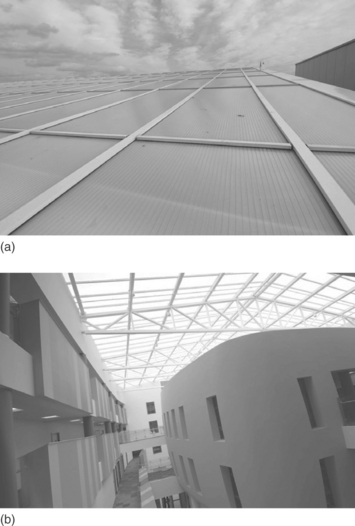
10.8 Application of Lumira™ aerogel in polycarbonate sheets, outer (a) and inner view (b). (courtesy of Roda, Germany)
Many daylighting systems with polycarbonate are proposed by TGP America, Advanced Glazings Ltd (Canada), and Xtralite (UK) (Dowson et al., 2011). Glazing systems with nanogel are also developed by Okalux, Germany: the system okagel® consists of two glass layers filled with granular aerogel. The system is filled with granulate in a controlled and continuous process and the façade appears homogeneous and translucent; moreover, in order to avoid the settlement of the material during the service life of the element, a hydrostatic stress state is applied to the material. Okagel can be used also in roof lights. The translucent material in the gap enables uniform lighting inside, avoiding glare problems, and exceptionally good thermal insulation, down to 0.3 W/(m2K). An interesting example of the application of Okagel is the Halley VI research station in the Antarctic (temperatures of − 60 °C can be reached), where 72 m2 Okagel façade elements with U-value of 0.3 W/m2K were installed.
Finally, Nano High-tech Co. Ltd is the largest research and production company in China; it developed several aerogel products, including day-lighting panels (TP), aerogel particles, and monoliths. Daylighting panels have a thermal conductivity equal to 0.025 W/mK and they can be used in large buildings such as theatres, airport terminals, exhibition centres, etc., both for daylighting and thermal insulation purposes. They are hydrophobic and the light transmittance is in the 40–70% range, depending on the panel thickness (10–30 mm). Further information about aerogel glazing systems (manufacturers and commercial products) is given in Table 10.2.
10.4 Performance of nanogel windows
The performance of innovative nanogel windows, when compared to conventional glazing systems, can be evaluated considering some important parameters:
• Light transmittance: the glazing system capacity to diffuse the natural light indoors is important since the natural light plays an active role in saving electric energy in the daytime and affects the general health of human beings; high values are required, in order to guarantee visual comfort and energy saving in lighting plants.
• Solar factor, g, and thermal transmittance, U-value influence the heat transferred through the glazing systems and the calculation of heating and cooling loads: low values are required, in order to guarantee thermal comfort and energy saving in HVAC plants.
• Sound reduction index, R, which influences the noise transmitted through the windows; high values are required in order to guarantee adequate acoustic comfort in buildings.
The optical transmission and the scattering properties of silica aerogels are widely discussed in the literature (Buratti, 2003; Jensen et al., 2004; Reim et al., 2005; Baetens et al., 2011; Buratti and Moretti, 2011a, 2011b, 2012a, 2012b). Aerogels show very interesting optical properties for building applications and their transmittance is high in the whole solar spectrum, including the visible range, where it is similar to that of a 6 mm thick clear float glass. Values of the light transmittance τv equal to 0.78 and of the solar transmittance τe equal to 0.80 were found for an aerogel pane 14 mm thick; significant absorption bands in the NIR transmission spectrum are shown (λ ≅ 1350 nm; λ ≅ 1900 nm; λ ≅ 2200 nm; λ ≅ 2500 nm) (Fig. 10.9). Furthermore, if only direct and total transmittance are compared, it could be observed that a part of the radiation is scattered when transmitted through the material, according to the Rayleigh scattering theory (Fig. 10.9, Buratti and Moretti, 2012b). It causes reddening of the transmitted light, the bluish appearance of the reflected light and a possible blurred deformation of optical images (Duer and Svendsen, 1998). A decrease in the optical quality of the vision through the material is observed; nevertheless, this behaviour could be preferred in some situations, because the light penetrates very deeply in the room and it can reduce significantly glare problems in façade or skylight.
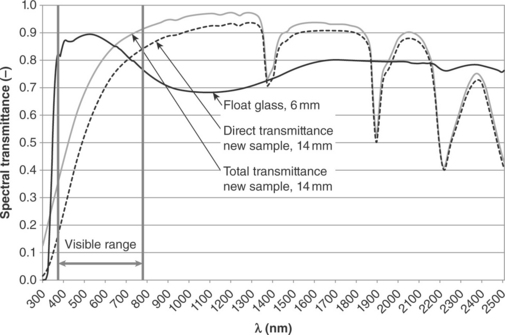
10.9 Aerogel pane transmission optical properties: direct and total solar spectral transmittance compared to a 6 mm thickness float glass (Buratti and Moretti, 2012b).
Using aerogel in clear windows can greatly affect the characteristics of the incoming light, modifying the colour appearance of surfaces and objects and contributing significantly to the comfort and visual satisfaction of human beings in indoor environments. The quality of the transmitted light can be usefully represented by the general colour rendering index Ra, which is calculated by applying the CIE standard procedure based on the differences in colour between eight test colours lighted directly by the reference illuminant D65 and by the same illuminant after the transmission through the glazing (EN 410, 2011); it is a normalized value in the 0–100 range. A value of 91 was found for 14 mm thickness aerogel panes, which is a good value if compared to the clear glass panes (Ra values of about 98). However, literature data (Buratti and Moretti, 2012b) showed a very good quality (Ra > 90) of the vision through the glazings with aerogel in the interspace: the colour rendering index is lower than those of the windows with air in the interspace (Ra = 98 with float glasses; Ra = 94 with one low-e glass), but it is equal to 93 for float glasses and granular aerogel (14 mm) and to 92 with monolithic aerogel. With low-e glasses, the Ra index reduces to 90–91.
As a final remark, the optical properties can be influenced furthermore by the production process, i.e. by selecting optimal synthesis parameters (Tajiri and Igarashi, 1998; Wagh et al., 1999) and the transparency was improved in the last years.
Both monolithic and granular aerogels could be assembled in the interspace of different glasses or polycarbonates to give transparent glazings. Different transmission properties are found for glazing systems with monolithic and granular aerogel in the interspace (Fig. 10.10). Samples with float glasses have the same trend, but the spectral transmittance of the samples with granular aerogel is up to 50% lower than that of the monolithic, above all in the visible range. The curve trend is representative of aerogel behaviour, reproducing the selective absorption peaks. Samples with low-e glass show a different trend for wavelengths higher than 800 nm, due to the low-e coating in the inner position. The solar transmittance, evaluated by means of the solar factor, is high for windows with monolithic translucent aerogels: the direct solar transmittance measured in the laboratory for a monolithic window prototype (15 mm aerogel) was higher than 75% (Jensen et al., 2004) but, at the same time, the U-value was equal to the best triple-layered gas-filled glazing units (U < 0.6 W/m2K). The net average energy balance on the window depends in fact on both the U-value and solar factor, in which case monolithic aerogel prototypes in evacuated conditions were better than the other highly insulating glazings (Fig. 10.11), especially in very cold climates such as in northern Europe: the improvements due to monolithic aerogel windows in a typical Danish single-family home were underlined by Schultz and Jensen (2008). A wide range of g-values can be found in the manufacturers’ technical data for daylighting systems with granular translucent aerogels, depending on the external retaining layers (glasses, low-e glasses, PMMA, polycarbonate) and on the total thickness (see Tables 10.1 and 10.2).
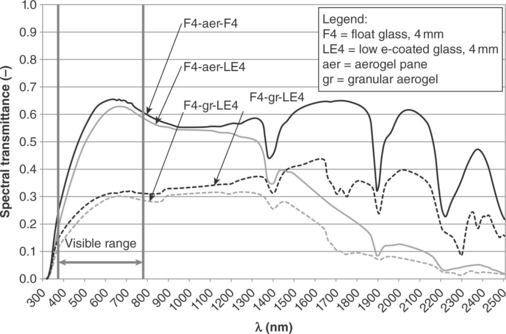
10.10 Spectral transmittance of different glazing samples with granular and monolithic aerogel in the interspace (Buratti and Moretti, 2012b).

10.11 Energy balance (kWh/m2) for window glazing as a function of U-value and solar factor. The curve represents the typical relationship for window glazing systems, the aerogel glazing position is shown by the star (Jelle et al., 2012).
Nanogel windows are excellent in the thermal insulation of buildings because of the very low thermal conductivity of transparent or translucent silica aerogel. As shown in Table 10.2, a wide range of U-values can be obtained for commercial products with translucent aerogels: the U-value can be as low as 0.48 W/(m2K) for polycarbonate solutions (polycarbonate sheets with Lumira™ aerogel, thickness = 50 mm, RODA, Germany), whereas U-values in glass solutions can be about 0.20 W(m2K) (translucent linear channel glass systems Pilkington ProfilitTM filled with 25 mm LumiraTM aerogel, Technical Glass Products, USA). The energy consumptions with triple-layered argon-filled glazing and with aerogel glazing were compared (Schultz and Jensen, 2008): the annual energy saving was about 1180 kWh/year (19%); in fact, in cold climates the increased heat insulation of triple glazing with respect to conventional double glazing can be thwarted by the g value decreasing (g-value is on the order of 0.4 for a argon-filled triple glazing). Considering a low-energy house, the savings become 700 kWh/year, which correspond to a 34% decrease in space heating demand.
Commercial applications with monolithic aerogels are not yet available, but U-values equal to 0.66 W/m2K were measured for a prototype of an evacuated glazing with only 13.5 mm thick aerogel pane (see Section 10.3.2). Furthermore, translucent insulating materials in glazing can have a major advantage when they are used in roof applications: the U-values of glazing systems with adequate layers of translucent nanogel are not dependent on the inclination to the vertical, while the gas-filled glazing with air or gas (argon or krypton) have a worse behaviour than that expected when they are used in roofs. The U-value is in fact calculated or measured for a vertical position, according to the international standards, but when they are horizontal, the warm air meets the colder outer side more quickly when rising, so an accelerated flow arises. The thermal convection in the cavity becomes higher and the U-value can be more than 50% higher than that measured or calculated in the vertical, as shown in Fig. 10.12.
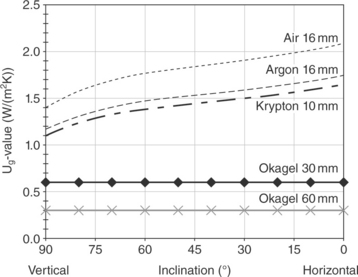
10.12 Dependence of U-value on the inclination for conventional glazing and glazing with translucent insulation materials (Okalux, 2012).
In order to characterize the acoustic properties of silica aerogels, the acoustic attenuation was measured according to the two-thickness method (Forest et al., 2001) and it showed that the large granules of aerogels (mean granule size: 3 mm) have a low attenuation (about 1 dB/cm), lower than that of a conventional insulating material, such as glass wool; nevertheless, in the small granules (mean granule size: about 80 μm) the attenuation values are in the 0–12 dB/cm range, depending on the frequency range: above 500 Hz, the values are higher than the glass wool ones (about 3 dB/ cm). The efficiency of granular silica aerogels as sound insulators in the 100–2500 Hz frequency range was also demonstrated when they are used in multilayer (a fist layer (1 cm) made of large granules and the second one (3 cm) made of small granules): in the 300–1700 Hz range, the sound transmitted through the aerogel is 15 dB lower than that transmitted through glass wool with the same thickness.
Finally, the translucent insulating material in the interspace of glazing can improve the sound insulation of the building envelope, in comparison with systems with air, as shown in Buratti and Moretti (2012b). A prototype of an aluminium frame window with granular aerogel glazing was produced and tested: aerogel in granular form was put in a gap 15 mm in depth; indoor and outdoor layers were float glasses of 4 mm thickness (Fig. 10.13). Both the thermal and acoustic performance in the building façades of the window prototype were evaluated in terms of measured U-value (hot box method, ISO 12567-1) and sound reduction index (R, EN ISO 10140-2) and they were compared with conventional glazing with air interspace (same thickness). A U-value of 0.99 W/m2K was found for the glazing with granular aerogel in the interspace. Furthermore, the presence of granular aerogel increases the sound reduction index values (Fig. 10.14) in all the frequency ranges (100–500 Hz), but above all in the central range (500–2000 Hz). Moreover, a weighted sound insulation index Rw (EN ISO 717-1, 2007) equal to 37 dB was obtained for the innovative prototype, 3 dB higher than that of the conventional window with air in the interspace (Rw = 34 dB), confirming good acoustic insulation properties.
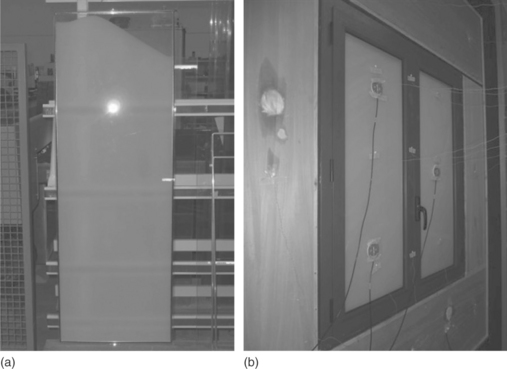
10.13 Setting-up of the aerogel glazing system with nanogel® (a) and window prototype during the laboratory test (b) (Buratti and Moretti, 2012a).
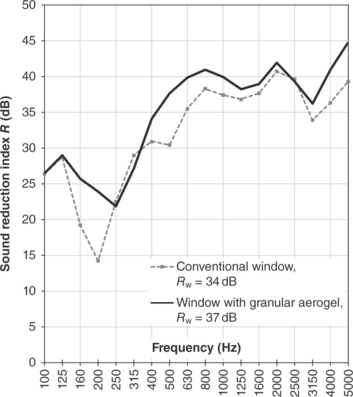
10.14 Sound reduction index (R) values vs. frequency for the conventional window and for the glazing prototype with aerogel in the interspace (Buratti and Moretti, 2012a).
10.5 Future trends
Further investigations about highly energy-efficient windows and skylights are needed in order to clarify several aspects and to improve some characteristics, such as:
• Aerogel glazings have the lowest potential U-values in the fenestration market, as low as 0.1 W/(m2K) and, due to their very interesting properties (thermal and acoustic insulation, lightness), they allow novel architectural daylighting solutions, but further effort and work are required to improve the visible transmittance.
• Research should be finalized to solve some problems such as the phenomenon of light scattering, which gives a reduced optical quality of vision through the material; furthermore, the production process is very complex and it does not allow the use of very large sheets of monolithic aerogels, without altering performance.
• Nowadays, alternative high-performance glazing solutions, such as vacuum insulation panels (VIP), have technical limits and at the same time very high costs: in fact, a functional VIP with U-values of 0.1 W/m2K is not available due to the problem of keeping the glazing gas-tight. Thus, the development of translucent or transparent aerogels, as a highly efficient insulating material to fill the glazing systems, seems at the moment the best possible thermal insulation system.
• Nanogel windows could become a decent alternative to conventional window solutions, above all in very cold climates, but aerogel manufacturers should put emphasis on cost reduction. A reference market price for silica aerogel (2008) is on the order of US$4000/m3, but a price of US$1500/m3 could be foreseen by 2020 with increasing commercialization. Concerning the applications in buildings, the price of commercial daylighting solutions with granular aerogel in polycarbonate sheets is on the order of €100–200/m2 (frame excluded), depending on the thickness (10–25 mm).
10.6 References
AbuBakr Bahaj, S., James, P.A.B., Jentsch, M.F. Potential of emerging glazing technologies for highly glazed buildings in hot arid climates. Energy and Buildings. 2008; 5:720–731.
Ackerman, W.C., Vlachos, M., Rouanet, S., Fruendt, J. Use of surface treated aerogels derived from various silica precursors in translucent insulation panels. Journal of Non-Crystalline Solids. 2001; 285:264–271.
Aegerter, M.A., Leventis, N., Koebel, M.M. Aerogels Handbook. Berlin: Springer; 2011.
Akimov, Y.K. Fields of application of aerogels (review). Instrument and Experiment Techniques. 2003; 3:287–299.
Anderson, A.M., Wattley, C.W., Carroll, M.K. Silica aerogels prepared via rapid supercritical extraction: effect of process variables on aerogel properties. Journal of Non-Crystalline Solids. 2009; 2:101–108.
Baetens, R., Jelle, B.P., Gustavsen, A. Aerogel insulation for building applications: a state-of-the-art review. Energy and Buildings. 2011; 43:761–769.
Buratti, C., Transparent insulating materials: experimental data and buildings energy savings evaluation. Proceedings of Energy & Environment 2003. First International Conference on Sustainable Energy, Planning & Technology in Relationship to the Environment. Halkidiki, Greece, 2003.
Buratti, C., Moretti, E., Transparent insulating materials for buildings energy savings: experimental results and performance evaluation. Proceedings of Third International Conference on Applied Energy. Perugia, Italy, 2011:16–18. [May 2011].
Buratti, C., Moretti, E. Lighting and energetic characteristics of transparent insulating materials: experimental data and calculation. Indoor and Built Environment. 2011; 20(4):400–411.
Buratti, C., Moretti, E. Experimental performance evaluation of aerogel glazing systems. Applied Energy. 2012; 97:430–437.
Buratti, C., Moretti, E. Glazing systems with silica aerogel for energy savings in buildings. Applied Energy. 2012; 98:396–403.
Dorcheh, A.S., Abbasi, H. Silica aerogel: synthesis, properties and characterization. Journal of Materials Processing Technology. 2008; 199:10–26.
Dowson, M., Harrison, D., Craig, S., Gill, Z. Improving the thermal performance of single-glazed windows using translucent granular aerogel. International Journal of Sustainable Engineering. 2011; 4(3):266–280.
Duer, K., Svendsen, S. Monolithic silica aerogel in superinsulating glazings. Solar Energy. 1998; 63:259–267.
Europe Parliament and the Council of the European Union, Directive 2002/91/EC of the European Parliament and of the Council of 16 December 2002 on the energy performance of buildings. Official Journal of the European Communities, 2002. [L1/65–L1/71].
EN 410, Glass in building – Determination of luminous and solar characteristics of glazing, 2011.
EN ISO 10140-2, Acoustics – Measurement of sound insulation in buildings and of building elements. Part 2: Laboratory measurements of airborne sound insulation of building elements, 2010.
EN ISO 717-1, Acoustics – Rating of sound insulation in buildings and of building elements. Part 1: Airborne sound insulation, 2007.
Forest, L., Gibiat, V., Woignier, T. Biot’s theory of acoustic propagation in porous media applied to aerogels and alcogels. Journal of Non-Crystalline Solids. 1998; 225:287–292.
Forest, L., Gibiat, V., Hooley, A. Impedance matching and acoustic absorption in granular layers of silica aerogels. Journal of Non-Crystalline Solids. 2001; 285:230–235.
Gross, J., Reichenauer, G., Fricke, J. Mechanical properties of SiO2 aerogels. Journal of Physics D:Applied Physics. 1988; 21:1447.
Hegde, N.D., Venkateswara Rao, A. Physical properties of methyltrimethoxysilane based elastic silica aerogels prepared by the two-stage sol-gel process. Journal of Material Science. 2007; 42:6965–6971.
ISO 12567-1, Thermal performance of windows and doors – Determination of thermal transmittance by the hot-box method – Part 1: Complete windows and doors, 2010.
Jelle, B.P., Hynd, A., Gustavsen, A., Arasteh, D., Goudey, H., Hart, R. Fenestration of today and tomorrow: a state-of-the-art review and future research opportunities. Solar Energy Materials & Solar Cells. 2012; 96:1–28.
Jensen, K.I., Schultz, J.M., Kristiansen, F.H. Development of windows based on highly insulating aerogel glazings. Journal of Non-Crystalline Solids. 2004; 350:351–357.
Kim, G.-S., Hyun, S.-H. Synthesis of window glazing coated with silica aerogel films via ambient drying. Journal of Non-Crystalline Solids. 2003; 320:125–132.
Kistler, S.S. Coherent expanded aerogels and jellies. Nature. 1931; 127:741.
Luo, L., Lu, H., Leventis, N. The compressive behavior of isocyanate cross- linked silica aerogel at high strain rates. Mechanical Time Depending Materials. 2006; 10:83–111.
Merget, R., Bauer, T., Kupper, H., Philippou, S., Bauer, H., Breitstadt, R., Bruening, T. Health hazards due to the inhalation of amorphous silica. Archives of Toxicology. 2002; 75:625–634.
Oral, G.K., Yener, A.K., Bayazit, N.T. Building envelope design with the objective to ensure thermal, visual and acoustic comfort conditions. Building and Environment. 2004; 3:281–287.
Pajonk, G.M. Some applications of silica aerogels. Colloid and Polymer Science. 2003; 281:637–651.
Parmenter, K.E., Milstein, F. Mechanical properties of silica aerogels. Journal of Non-Crystalline Solids. 1998; 223(3):179–189.
Pérez-Lombard, L., Ortiz, J., Pout, C. A review on buildings energy consumption information. Energy and Buildings. 2008; 40:394–398.
Research, Pike. Energy efficient buildings: global outlook. available at: http://www.pikeresearch.com/research/energy-efficient-buildings-global-outlook, 2011.
Pierre, A.C., Pajonk, G.M. Chemistry of aerogels and their applications. Chemical Reviews. 2002; 102:4243–4265.
Reim, M., Beck, A., Körner, W., Petricevic, R., Glora, M., Weth, M., Schliermann, T., Schmidtch, Pötter F.J., Fricke, J. Highly insulating aerogel glazing for solar energy usage. Solar Energy. 2002; 1:21–29.
Reim, M., Reichenauer, G., Körner, W., Manara, J., Arduini-Schuster, M., Korder, S., Beck, A., Fricke, J. Silica-aerogel granulate – structural, optical and thermal properties. Journal of Non-Crystalline Solids. 2004; 350:358–363.
Reim, M., Korner, W., Manara, J., Korder, S., Arduini-Schuster, M., Ebert, H.P., Fricke, J. Silica aerogel granulate material for thermal insulation and daylighting. Solar Energy. 2005; 2:131–139.
Rigacci, A., Einarsrud, M., Nilsen, E., Pirard, R., Ehrburger-Dolle, F., Chevalier, B. Improvement of the silica aerogel strengthening process for scaling-up monolithic tile production. Journal of Non-Crystalline Solids. 2004; 350:196–201.
Schultz, J.M., Jensen, K.I. Evacuated aerogel glazings. Vacuum. 2008; 82:723–v729.
Schultz, J.M., Jensen, K.I., Kristiansen, F.H. Super insulating aerogel glazing. Solar Energy Materials and Solar Cells. 2005; 89:275–285.
Tajiri, K., Igarashi, K. The effect of the preparation conditions on the optical properties of transparent silica aerogels. Solar Energy Materials and Solar Cells. 1998; 4:189–195.
Wagh, P.B., Begar, R., Pajonk, G.M., Venkateswara Rao, A., Haranath, D. Comparison of some physical properties of silica aerogel monoliths synthesized by different precursors. Materials Chemistry and Physics. 1999; 57:214–218.
Woignier, T., Phalippou, J., Sempere, R., Pelous, J. Analysis of the elastic behaviour of silica aerogels taken as a percolating system. Journal of Physics –France. 1988; 49:289–293.
Zanetti Freire, R., Mazuroski, W., Abadie, O., Mendes, N. Capacitive effect on the heat transfer through building glazing systems. Applied Energy. 2011; 88:4310–4319.
References websites
Advanced Glazings Ltd, Canada. http://www.advancedglazings.com/nanogel (last accessed on September 22, 2012).
Airglass AB, Sweden. http://www.airglass.se/ (last accessed on September 22, 2012).
Cabot Corporation, USA. http://www.cabot-corp.com/Aerogel (last accessed on September 22, 2012).
Kalwall Corporation, USA. http://www.kalwall.com/aerogel.htm (last accessed on September 22, 2012).
Nano High-Tech Co., Ltd, China. http://www.nanuo.cn/english/product-3.htm (last accessed on September 22, 2012).
Okalux GmbH, Germany. http://www.okalux.com (last accessed on September 22, 2012).
Roda E.M.B. Products AG, Germany. http://www.roda.de/download_en_22.html (last accessed on September 22, 2012).
Technical Glass Products, USA. http://www.tgpamerica.com/structural-glass/pilkington-profilit/ (last accessed on September 22, 2012).
Xtralite Rooflight, UK. http://www.xtralite.co.uk/products/specialist-glazing/lumiratechnology/ (last accessed on September 22, 2012).


